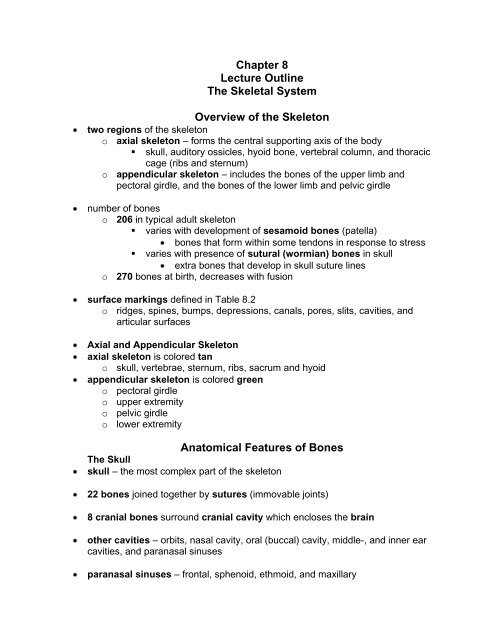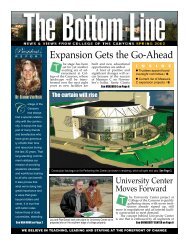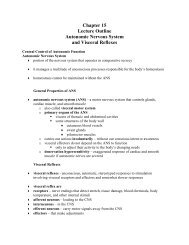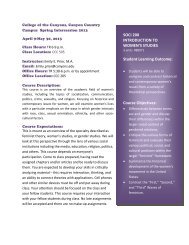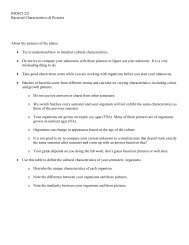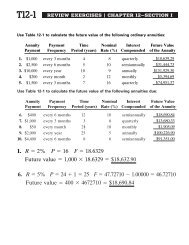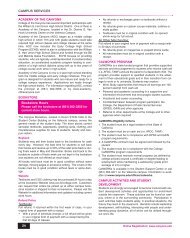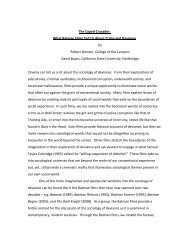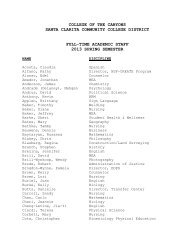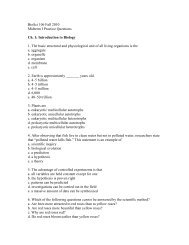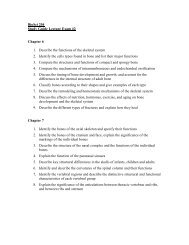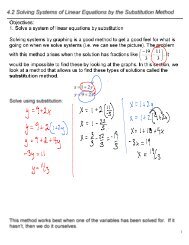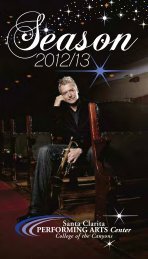Chapter 8 Lecture Outline The Skeletal System Overview of the ...
Chapter 8 Lecture Outline The Skeletal System Overview of the ...
Chapter 8 Lecture Outline The Skeletal System Overview of the ...
You also want an ePaper? Increase the reach of your titles
YUMPU automatically turns print PDFs into web optimized ePapers that Google loves.
<strong>Chapter</strong> 8<br />
<strong>Lecture</strong> <strong>Outline</strong><br />
<strong>The</strong> <strong>Skeletal</strong> <strong>System</strong><br />
<strong>Overview</strong> <strong>of</strong> <strong>the</strong> Skeleton<br />
two regions <strong>of</strong> <strong>the</strong> skeleton<br />
o axial skeleton – forms <strong>the</strong> central supporting axis <strong>of</strong> <strong>the</strong> body<br />
skull, auditory ossicles, hyoid bone, vertebral column, and thoracic<br />
cage (ribs and sternum)<br />
o appendicular skeleton – includes <strong>the</strong> bones <strong>of</strong> <strong>the</strong> upper limb and<br />
pectoral girdle, and <strong>the</strong> bones <strong>of</strong> <strong>the</strong> lower limb and pelvic girdle<br />
number <strong>of</strong> bones<br />
o 206 in typical adult skeleton<br />
varies with development <strong>of</strong> sesamoid bones (patella)<br />
bones that form within some tendons in response to stress<br />
varies with presence <strong>of</strong> sutural (wormian) bones in skull<br />
extra bones that develop in skull suture lines<br />
o 270 bones at birth, decreases with fusion<br />
surface markings defined in Table 8.2<br />
o ridges, spines, bumps, depressions, canals, pores, slits, cavities, and<br />
articular surfaces<br />
Axial and Appendicular Skeleton<br />
axial skeleton is colored tan<br />
o skull, vertebrae, sternum, ribs, sacrum and hyoid<br />
appendicular skeleton is colored green<br />
o pectoral girdle<br />
o upper extremity<br />
o pelvic girdle<br />
o lower extremity<br />
Anatomical Features <strong>of</strong> Bones<br />
<strong>The</strong> Skull<br />
skull – <strong>the</strong> most complex part <strong>of</strong> <strong>the</strong> skeleton<br />
22 bones joined toge<strong>the</strong>r by sutures (immovable joints)<br />
8 cranial bones surround cranial cavity which encloses <strong>the</strong> brain<br />
o<strong>the</strong>r cavities – orbits, nasal cavity, oral (buccal) cavity, middle-, and inner ear<br />
cavities, and paranasal sinuses<br />
paranasal sinuses – frontal, sphenoid, ethmoid, and maxillary
o lined by mucous membrane and air-filled<br />
o lighten <strong>the</strong> anterior portion <strong>of</strong> <strong>the</strong> skull<br />
o act as chambers that add resonance to <strong>the</strong> voice<br />
foramina – holes that allow passage for nerves and blood vessels<br />
14 facial bones support teeth, facial and jaw muscles<br />
Major Skull Cavities<br />
Cranial Fossa<br />
cranium (braincase) – protects <strong>the</strong> brain and associated sense organs<br />
o swelling <strong>of</strong> <strong>the</strong> brain inside <strong>the</strong> rigid cranium may force tissue through<br />
foramen magnum resulting in death<br />
o consists <strong>of</strong> two parts: <strong>the</strong> calvaria (skullcap) and <strong>the</strong> cranial base<br />
base is divided into three basins that comprise <strong>the</strong> cranial floor<br />
o anterior cranial fossa holds <strong>the</strong> frontal lobe <strong>of</strong> <strong>the</strong> brain<br />
o middle cranial fossa holds <strong>the</strong> temporal lobes <strong>of</strong> <strong>the</strong> brain<br />
o posterior cranial fossa contains <strong>the</strong> cerebellum<br />
Frontal Bone<br />
forms forehead and part <strong>of</strong> <strong>the</strong> ro<strong>of</strong> <strong>of</strong> <strong>the</strong> cranium<br />
coronal suture – posterior boundary <strong>of</strong> frontal bone<br />
supraorbital margin forms ro<strong>of</strong> <strong>of</strong> <strong>the</strong> orbit<br />
supraorbital foramen provides passage for nerve, artery, and vein<br />
contains frontal sinus<br />
Parietal Bone<br />
form most <strong>of</strong> cranial ro<strong>of</strong> and part <strong>of</strong> its lateral walls<br />
bordered by 4 sutures<br />
o sagittal – between parietal bones<br />
o coronal – at anterior margin<br />
o lambdoid – at posterior margin<br />
o squamous – at lateral border<br />
two temporal lines serve as attachment <strong>of</strong> <strong>the</strong> temporalis muscle<br />
Temporal Bone<br />
lateral wall and part <strong>of</strong> floor <strong>of</strong> cranial cavity<br />
o squamous part<br />
encircled by squamous suture
zygomatic process<br />
mandibular fossa<br />
o tympanic part<br />
external auditory meatus<br />
styloid process<br />
o mastoid part<br />
mastoid process<br />
mastoiditis from ear infection<br />
mastoid notch<br />
stylomastoid foramen<br />
mastoid foramen<br />
Petrous Portion <strong>of</strong> Temporal Bone<br />
o petrous part<br />
internal auditory meatus<br />
- opening for CN VII (vestibulocochlear nerve)<br />
carotid canal<br />
jugular foramen<br />
Occipital Bone<br />
rear and base <strong>of</strong> skull<br />
foramen magnum holds spinal cord<br />
skull rests on atlas at occipital condyles<br />
hypoglossal canal transmits hypoglossal nerve (CN XII) supplying tongue<br />
muscles<br />
condylar canal<br />
external occipital protuberance for nuchal ligament<br />
superior and inferior nuchal lines mark neck muscles<br />
Sphenoid Bone<br />
body<br />
greater wing<br />
lesser wing
optic foramen<br />
superior orbital fissure<br />
Ethmoid Bone<br />
superior and middle concha<br />
Cribiform plate<br />
Crista galli<br />
Facial Bones<br />
facial bones (14)– those that have no direct contact with <strong>the</strong> brain or meninges<br />
o support <strong>the</strong> teeth<br />
o give shape and individuality to <strong>the</strong> face<br />
o form part <strong>of</strong> <strong>the</strong> orbital and nasal cavities<br />
o provide attachments for muscles <strong>of</strong> facial expression and mastication<br />
2 maxillae 2 nasal bones<br />
2 palatine bones 2 inferior nasal conchae<br />
2 zygomatic bones 1 vomer<br />
2 lacrimal bones 1 mandible<br />
Maxillary Bones<br />
largest facial bones<br />
forms upper jaw and meet each o<strong>the</strong>r at a median intermaxillary suture<br />
o alveolar processes are bony points<br />
between teeth<br />
o alveolus - sockets that hold teeth<br />
forms inferomedial wall <strong>of</strong> orbit<br />
o infraorbital foramen<br />
o inferior orbital fissure<br />
forms most <strong>of</strong> <strong>the</strong> hard palate<br />
o palatine process<br />
o palate – forms <strong>the</strong> ro<strong>of</strong> <strong>of</strong> <strong>the</strong> mouth and floor <strong>of</strong> nasal cavity<br />
o incisive foramen<br />
o palate allows us to chew while breathing<br />
o cleft palate and cleft lip<br />
Location <strong>of</strong> Maxillary Sinus<br />
maxillary sinus fills maxillae bone<br />
larger in volume than frontal, sphenoid and ethmoid sinuses<br />
Palatine Bones<br />
L-shaped bone
form <strong>the</strong> posterior portion <strong>of</strong> <strong>the</strong> hard palate<br />
part <strong>of</strong> lateral nasal cavity wall<br />
part <strong>of</strong> <strong>the</strong> orbital floor<br />
greater palatine foramina<br />
Zygomatic Bones<br />
forms angles <strong>of</strong> <strong>the</strong> cheekbones and part <strong>of</strong> lateral orbital wall<br />
zygomatic arch is formed from temporal process <strong>of</strong> zygomatic bone and<br />
zygomatic process <strong>of</strong> temporal bone<br />
Lacrimal Bones<br />
form part <strong>of</strong> medial wall <strong>of</strong> each orbit<br />
smallest bone <strong>of</strong> skull<br />
lacrimal fossa houses lacrimal sac in life<br />
o tears collect in lacrimal sac and drain into nasal cavity<br />
Nasal Bones (nasalis)<br />
forms bridge <strong>of</strong> nose<br />
supports cartilages that shape lower portion <strong>of</strong> <strong>the</strong> nose<br />
<strong>of</strong>ten fractured by blow to <strong>the</strong> nose<br />
Inferior Nasal Conchae<br />
three conchae in <strong>the</strong> nasal cavity<br />
o superior and middle are part <strong>of</strong> <strong>the</strong> ethmoid bone<br />
inferior nasal concha is a separate bone<br />
largest <strong>of</strong> <strong>the</strong> three<br />
Vomer<br />
inferior half <strong>of</strong> <strong>the</strong> nasal septum<br />
o superior half formed by perpendicular plate <strong>of</strong> ethmoid<br />
supports cartilage that forms <strong>the</strong> anterior part <strong>of</strong> <strong>the</strong> nasal septum<br />
Mandible<br />
strongest bone <strong>of</strong> <strong>the</strong> skull
only bone <strong>of</strong> skull that moves noticeably<br />
supports lower teeth<br />
provides attachments for muscles <strong>of</strong> facial expression and mastication<br />
mental symphysis – median cartilaginous joint in fetus<br />
o develops as two separate bones in fetus<br />
o ossifies in early childhood<br />
mental protuberance – point <strong>of</strong> chin<br />
two major parts on each side<br />
o body – supports teeth<br />
o ramus – articulates with cranium<br />
angle – where body and ramus meet<br />
alveolar processes between teeth<br />
mental foramen<br />
Ramus, Angle and Body <strong>of</strong> Mandible<br />
condylar process bears <strong>the</strong> mandibular condyle – oval knob that articulates<br />
with <strong>the</strong> mandibular fossa <strong>of</strong> <strong>the</strong> temporal bone forming <strong>the</strong> hinge<br />
temporomandibular joint (TMJ)<br />
coronoid process – point <strong>of</strong> insertion <strong>of</strong> temporalis muscle<br />
mandibular notch<br />
mandibular foramen<br />
Bones Associated With Skull<br />
auditory ossicles<br />
o three in each middle-ear cavity<br />
o malleus, incus, and stapes<br />
hyoid bone<br />
o slender u-shaped bone between <strong>the</strong> chin and larynx<br />
o does not articulate with any o<strong>the</strong>r bone<br />
o suspended from styloid process <strong>of</strong> skull by muscle and ligament<br />
o body and greater and lesser horns (cornua)<br />
o fractured hyoid bone is evidence <strong>of</strong> strangulation<br />
Skull in Infancy and Childhood<br />
fontanels - spaces between unfused bones<br />
o filled with fibrous membrane<br />
o allow shifting <strong>of</strong> bones during birth and growth <strong>of</strong> brain<br />
o anterior, posterior, sphenoid (anterolateral), and mastoid<br />
(posterolateral fontanels<br />
two frontal bones fuse by age 6
skull reaches adult size by 8 or 9 years <strong>of</strong> age<br />
<strong>The</strong> Vertebral Column (Spine)<br />
functions<br />
o supports <strong>the</strong> skull and trunk<br />
o allows for <strong>the</strong>ir movement<br />
o protects <strong>the</strong> spinal cord<br />
o absorbs stress <strong>of</strong> walking, running, and lifting<br />
o provides attachments for limbs thoracic cage, and postural muscles<br />
33 vertebrae with intervertebral discs <strong>of</strong> fibrocartilage between most <strong>of</strong> <strong>the</strong>m<br />
adult vertebral column averages 71 cm. (28 in.) long<br />
o intervertebral discs account for about one-quarter <strong>of</strong> its length<br />
o person is 1% shorter when <strong>the</strong>y go to bed<br />
o compression squeezes water out during <strong>the</strong> day and absorbs water when<br />
compression removed during sleep<br />
five vertebral groups<br />
o 7 cervical in <strong>the</strong> neck<br />
o 12 thoracic in <strong>the</strong> chest<br />
o 5 lumbar in lower back<br />
o 5 fused sacral at base <strong>of</strong> spine<br />
o 4 fused coccygeal<br />
variations in number <strong>of</strong> lumbar and sacral vertebrae occur in 1 in 20 people<br />
Newborn Spinal Curvature<br />
spine exhibits one continuous C-shaped curve at birth<br />
known as primary curvature<br />
Adult Spinal Curvatures<br />
s-shaped vertebral column with four normal curvatures<br />
o cervical<br />
o thoracic<br />
o lumbar<br />
o pelvic<br />
primary curvatures – present at birth<br />
o thoracic and pelvic<br />
secondary curvatures – develop later<br />
o cervical and lumbar<br />
o lifting head as it begins to crawl develops cervical curvature
o walking upright develops lumbar curvature<br />
Abnormal Spinal Curvatures<br />
from disease, paralysis <strong>of</strong> trunk muscles, poor posture, pregnancy, or congenital<br />
defect<br />
scoliosis – abnormal lateral curvature<br />
o most common<br />
o usually in thoracic region<br />
o particularly <strong>of</strong> adolescent girls<br />
o developmental abnormality in which <strong>the</strong> body and arch fail to develop on<br />
one side <strong>of</strong> <strong>the</strong> vertebrae<br />
kyphosis (hunchback) – exaggerated thoracic curvature<br />
o usually from osteoporosis, also osteomalacia or spinal tuberculosis, or<br />
wrestling or weightlifting in young boys<br />
lordosis (swayback) – exaggerated lumbar curvature<br />
o is from pregnancy or obesity<br />
General Structure <strong>of</strong> Vertebra<br />
body (centrum)<br />
o mass <strong>of</strong> spongy bone that contains red bone marrow<br />
o covered with thin shell <strong>of</strong> compact bone<br />
o weight bearing portion<br />
o rough superior and inferior surfaces provide firm attachment for<br />
intervertebral discs<br />
vertebral foramina<br />
o collectively form vertebral canal for spinal cord<br />
vertebral arch<br />
o composed <strong>of</strong> two parts on each side<br />
o pedicle – pillarlike and lamina - platelike<br />
spinous process<br />
o projection extending from <strong>the</strong> apex <strong>of</strong> arch<br />
o extends posteriorly and downward<br />
transverse process<br />
o extends laterally from point where pedicel and lamina meet<br />
superior articular processes<br />
o project upward from one vertebra and meets inferior articular processes<br />
from <strong>the</strong> vertebra above<br />
facets<br />
o flat articular surfaces covered with hyaline cartilage<br />
Intervertebral Foramen and Discs<br />
intervertebral foramen
o when two vertebrae are joined <strong>the</strong>y exhibit and opening between <strong>the</strong>ir<br />
pedicles<br />
o passageway for spinal nerves<br />
o inferior vertebral notch in <strong>the</strong> pedicle <strong>of</strong> <strong>the</strong> upper vertebra<br />
o superior vertebral notch in <strong>the</strong> pedicle <strong>of</strong> <strong>the</strong> lower vertebra<br />
intervertebral discs (23)<br />
o first one between C2 and C3<br />
o last one between L5 and sacrum<br />
o pad consisting <strong>of</strong>:<br />
nucleus pulposus - inner gelatinous mass<br />
anulus fibrosus – outer ring <strong>of</strong> fibrocartilage<br />
o bind vertebrae toge<strong>the</strong>r<br />
o support weight <strong>of</strong> <strong>the</strong> body<br />
o absorb shock<br />
o herniated disc (‘ruptured’ or ‘slipped’ disc) puts painful pressure on spinal<br />
nerve or spinal cord<br />
Cervical Vertebra C1 - Atlas<br />
atlas (C1)<br />
o supports <strong>the</strong> head<br />
o has no body<br />
o a delicate ring surrounding a large vertebral foramen<br />
o lateral masses with superior articular facets<br />
articulates with occipital condyles<br />
allows nodding motion <strong>of</strong> skull gesturing ‘yes’<br />
o inferior articular facets articulate with C2<br />
o anterior and posterior arches<br />
o anterior and posterior tubercles<br />
Cervical Vertebra C2 - Axis<br />
axis (C2)<br />
o allows rotation <strong>of</strong> <strong>the</strong> head gesturing ‘no’<br />
o dens or odontoid process – prominent knob on its anterosuperior side<br />
forms as an independent ossification center during first year <strong>of</strong> life<br />
fuses with axis by age 3 to 6 years<br />
projects into vertebral foramen <strong>of</strong> <strong>the</strong> atlas<br />
held in place by a transverse ligament<br />
o atlanto-occipital joint – joint between atlas and cranium<br />
o atlantoaxial joint – joint between <strong>the</strong> atlas and axis<br />
Typical Cervical Vertebrae<br />
C1-C7 are <strong>the</strong> smallest and lightest vertebrae, o<strong>the</strong>r than <strong>the</strong> coccygeals<br />
bifid or forked spinous process in C2 to C6<br />
small body and larger vertebral foramen<br />
transverse foramen in each short transverse process
o provides passage and protection for:<br />
vertebral arteries – supply blood to <strong>the</strong> brain<br />
vertebral veins – drain blood from various neck structures<br />
o transverse foramen only found in cervical vertebrae<br />
C7 vertebra prominens – spinous process not bifid and especially long<br />
o prominent bump on <strong>the</strong> lower back <strong>of</strong> <strong>the</strong> neck<br />
o convenient landmark for counting vertebrae<br />
Typical Thoracic Vertebrae<br />
Lumbar Vertebrae<br />
5 lumbar vertebrae (L1 – L5)<br />
thick, stout body<br />
blunt, squarish spinous process<br />
superior articular processes face medially<br />
o lumbar region resistant to twisting movements<br />
Sacrum (Anterior View)<br />
sacrum – bony plate that forms <strong>the</strong> posterior wall <strong>of</strong> <strong>the</strong> pelvic cavity<br />
once considered <strong>the</strong> seat <strong>of</strong> <strong>the</strong> soul<br />
in children, five separate sacral vertebrae (S1 – S5)<br />
begin fusion around age 16 and complete fusion by age 26<br />
anterior surface<br />
o smooth and concave<br />
o 4 transverse lines indicate line <strong>of</strong> fusion <strong>of</strong> vertebrae<br />
o 4 pair <strong>of</strong> large anterior sacral (pelvic) foramina<br />
allow for passage <strong>of</strong> nerves and arteries into <strong>the</strong> pelvic organs<br />
sacral promontory on S1 supports L5<br />
Sacrum (Posterior View)<br />
posterior surface very rough<br />
median sacral crest<br />
o formed from fusion <strong>of</strong> spinous processes<br />
lateral sacral crest<br />
o less prominent, and on ei<strong>the</strong>r side <strong>of</strong> median sacral crest<br />
o formed from <strong>the</strong> fusion <strong>of</strong> <strong>the</strong> transverse processes<br />
posterior sacral foramina<br />
o 4 pairs <strong>of</strong> openings for spinal nerves that supply gluteal region and lower<br />
limbs<br />
sacral canal runs through sacrum and ends as sacral hiatus<br />
o contains spinal nerve roots<br />
auricular surface is part <strong>of</strong> sacroiliac (SI) joint formed with hip bone<br />
superior articular processes on S1<br />
o articulates with L5
alae – pair <strong>of</strong> large, rough, winglike extensions lateral to <strong>the</strong> superior articular<br />
processes<br />
Coccyx<br />
coccyx – usually consists <strong>of</strong> four small vertebrae (Co1 – Co4)<br />
o sometimes five<br />
fuse into a single, triangular bone by age 20 – 30<br />
horns (cornua) on Co1<br />
o serves as attachment points for ligaments that bind <strong>the</strong> coccyx to <strong>the</strong><br />
sacrum<br />
fractured during difficult childbirth or by hard fall on buttocks<br />
provide attachment for muscles <strong>of</strong> <strong>the</strong> pelvic floor<br />
Thoracic Cage<br />
consists <strong>of</strong> thoracic vertebrae, sternum and ribs<br />
forms conical enclosure for lungs and heart<br />
provides attachment for pectoral girdle and upper limbs<br />
broad base and narrower apex<br />
rhythmically expanded by respiratory muscles to draw air into <strong>the</strong> lungs<br />
costal margin – inferior border <strong>of</strong> thoracic cage formed by <strong>the</strong> downward arc <strong>of</strong><br />
ribs<br />
protect thoracic organs, but also <strong>the</strong> spleen, most <strong>of</strong> <strong>the</strong> liver, and to some<br />
extent <strong>the</strong> kidneys<br />
Sternum<br />
sternum (breastbone) – bony plate anterior to <strong>the</strong> heart<br />
divided into three regions:<br />
o manubrium<br />
broad superior portion<br />
suprasternal (jugular) notch medially<br />
clavicular notches – articulate with clavicle<br />
ribs attach along scalloped lateral margins<br />
o body (gladiolus)<br />
longest part <strong>of</strong> sternum<br />
sternal angle – point where body joins manubrium<br />
ribs attach along scalloped lateral margins<br />
o xiphoid<br />
inferior end <strong>of</strong> sternum<br />
attachment for some <strong>of</strong> abdominal muscles
in cardiopulmonary resuscitation, improperly performed chest<br />
compressions can drive xiphoid process into <strong>the</strong> liver and cause<br />
a fatal hemorrhage<br />
Ribs<br />
12 pairs <strong>of</strong> ribs<br />
o no difference between sexes<br />
o posterior (proximal) end attached to vertebral column<br />
o anterior (distal) ends mostly attached to <strong>the</strong> sternum<br />
o costal cartilages composed <strong>of</strong> hyaline cartilage attach anterior ends to<br />
sternum<br />
head – portion <strong>of</strong> <strong>the</strong> rib that articulates with <strong>the</strong> thoracic vertebrae<br />
o superior articular facet<br />
o inferior articular facet<br />
neck – narrow portion distal to <strong>the</strong> head<br />
tubercle – wider rough area distal to <strong>the</strong> neck<br />
o articulates with transverse costal facet <strong>of</strong> vertebra<br />
angle – lateral curve <strong>of</strong> rib<br />
shaft – long, gentle sloping, bladelike portion <strong>of</strong> rib<br />
o costal groove on inferior margin <strong>of</strong> shaft<br />
True and False Ribs<br />
true ribs (ribs 1 to 7)<br />
o each has its own costal cartilage connecting it to <strong>the</strong> sternum<br />
false ribs (ribs 8-12)<br />
o lack independent cartilaginous connection to <strong>the</strong> sternum<br />
o floating ribs (ribs 11 – 12)<br />
articulate with bodies <strong>of</strong> vertebrae T11 and T12<br />
do not have tubercles<br />
do not attach to transverse processes <strong>of</strong> <strong>the</strong> vertebra<br />
no cartilaginous connection to <strong>the</strong> sternum or any <strong>of</strong> <strong>the</strong><br />
higher costal cartilages<br />
Pectoral Girdle<br />
pectoral girdle (shoulder girdle) – supports <strong>the</strong> arm<br />
consists <strong>of</strong> two bones on each side <strong>of</strong> <strong>the</strong> body<br />
o clavicle (collarbone) and scapula (shoulder blade)<br />
clavicle articulates medially to <strong>the</strong> sternum and laterally to <strong>the</strong> scapula<br />
o sternoclavicular joint<br />
o acromioclavicular joint<br />
scapula articulates with <strong>the</strong> humerus<br />
o glenohumeral joint - shoulder joint<br />
o easily dislocated due to loose attachment<br />
Clavicle<br />
clavicle - S-shaped, somewhat flattened bone
inferior – grooves and ridges for muscle attachment<br />
sternal end - rounded head<br />
acromial end – flattened<br />
o conoid tubercle – roughened tuberosity near acromial end<br />
o ligament attachment<br />
braces <strong>the</strong> shoulder keeping upper limb away from <strong>the</strong> midline <strong>of</strong> <strong>the</strong> body<br />
most frequently fractured bone in <strong>the</strong> body<br />
Scapula<br />
scapula – named for its resemblance to a spade or shovel<br />
triangular plate that posteriorly overlies ribs 2 to 7<br />
o three sides - superior, medial (vertebral) and lateral (axillary) borders<br />
o three angles – superior, inferior, and lateral angles<br />
suprascapular notch – conspicuous notch on superior border<br />
o provides passage for a nerve<br />
spine – transverse ridge on posterior surface<br />
o supraspinous fossa – indentation superior to <strong>the</strong> spine<br />
o infraspinous fossa – broad surface inferior to <strong>the</strong> spine<br />
subscapular fossa – concave, anterior surface <strong>of</strong> scapula<br />
complex lateral angle <strong>of</strong> scapula has three main features:<br />
o acromion – platelike extension <strong>of</strong> <strong>the</strong> spine<br />
forms apex <strong>of</strong> <strong>the</strong> shoulder<br />
articulates with <strong>the</strong> clavicle – <strong>the</strong> sole point <strong>of</strong> attachment <strong>of</strong> <strong>the</strong><br />
scapula and <strong>the</strong> upper limb to <strong>the</strong> rest <strong>of</strong> <strong>the</strong> skeleton<br />
o coracoid process – shaped like a bent finger<br />
provides attachment for tendons <strong>of</strong> <strong>the</strong> biceps brachii and o<strong>the</strong>r arm<br />
muscles<br />
o glenoid cavity – shallow socket that articulates with <strong>the</strong> head <strong>of</strong> <strong>the</strong><br />
humerus<br />
forming glenohumeral joint<br />
upper limb is divided into four regions containing a total <strong>of</strong> 30 bones per limb<br />
o brachium (arm proper) – extends from shoulder to elbow<br />
contains only one bone - humerus<br />
o antebrachium (forearm) – extends from elbow to wrist<br />
contains two bones - radius and ulna<br />
o carpus (wrist)
contains 8 small bones arranged in 2 rows<br />
o manus (hand)<br />
19 bones in 2 groups<br />
5 metacarpals in palm<br />
14 phalanges in fingers<br />
Humerus<br />
proximal end<br />
o hemispherical head that articulates with <strong>the</strong> glenoid cavity <strong>of</strong> scapula<br />
o anatomical neck<br />
o greater and lesser tubercles and deltoid tuberosity<br />
o intertubercular sulcus holds biceps tendon<br />
o surgical neck<br />
distal end<br />
o rounded capitulum articulates with head <strong>of</strong> radius<br />
o trochlea articulates with ulna<br />
o lateral and medial epicondyles<br />
o lateral and medial supracondylar ridges<br />
o olecranon fossa holds olecranon process <strong>of</strong> ulna<br />
o coronoid fossa<br />
o radial fossa<br />
Radius<br />
radius<br />
o head – disc-shape, allows for rotation around <strong>the</strong> longitudinal axis <strong>of</strong> <strong>the</strong><br />
bone during pronation and supination <strong>of</strong> hand<br />
superior surface articulates with capitulum on humerus<br />
side <strong>of</strong> disc spins on radial notch on ulna<br />
o neck<br />
o radial tuberosity for biceps muscle<br />
o styloid process can be palpated near thumb<br />
o ulnar notch<br />
Ulna<br />
ulna<br />
o trochlear notch articulates with trochlea <strong>of</strong> humerus<br />
o olecranon – bony point at back <strong>of</strong> elbow<br />
o coronoid process<br />
o radial notch holds head <strong>of</strong> radius<br />
o styloid process<br />
interosseous membrane<br />
o ligament attaches radius to ulna along interosseous margin <strong>of</strong> each<br />
bone
o enables <strong>the</strong> two elbow joints to share <strong>the</strong> load<br />
Carpal Bones<br />
8 bones form wrist<br />
o allow movements <strong>of</strong> flexion, extension, abduction and adduction<br />
2 rows (4 bones each)<br />
o proximal row –<br />
o scaphoid, lunate, triquetrum, and pisiform<br />
pisiform is a sesamoid developed by age 9 to12 in tendon <strong>of</strong> flexor<br />
carpi ulnaris muscle<br />
o distal row - trapezium, trapezoid, capitate, and hamate<br />
Sesamoid Bone<br />
pisiform<br />
Metacarpals and Phalanges<br />
o develops around age 9 – 12 years<br />
o in tendon <strong>of</strong> flexor carpi ulnaris muscle<br />
Pelvic Girdle<br />
pelvic girdle – consists <strong>of</strong> a complete ring composed <strong>of</strong> three bones<br />
o two hip (coxal) bones<br />
also called ossa coxae or innominate bones<br />
o sacrum that is also part <strong>of</strong> <strong>the</strong> vertebral column<br />
pelvis – bowl-shaped structure composed <strong>of</strong> <strong>the</strong> two coxal bones and sacrum as<br />
well as <strong>the</strong>ir ligaments and muscles that line <strong>the</strong> pelvic cavity and form its floor<br />
o supports trunk on <strong>the</strong> lower limbs<br />
and protects viscera, lower colon, urinary bladder, and internal<br />
reproductive organs<br />
sacroiliac joint - joins hipbone to<br />
<strong>the</strong> vertebral column<br />
o auricular surface <strong>of</strong> ileum to auricular surface <strong>of</strong> sacrum<br />
anteriorly, interpubic disc – pad <strong>of</strong> fibrocartilage joins pubic bones<br />
pubic symphysis – <strong>the</strong> interpubic disc and adjacent regions <strong>of</strong> <strong>the</strong> pubic bone<br />
on each side<br />
Pelvic Inlet and Outlet<br />
greater (false) pelvis – between flare <strong>of</strong> <strong>the</strong> hips<br />
lesser (true) pelvis – narrower and below<br />
pelvic brim – round margin that separates <strong>the</strong> two
pelvic inlet – opening circumscribed by brim that infant’s head must pass during<br />
birth<br />
pelvic outlet – lower margin <strong>of</strong> <strong>the</strong> lesser pelvis<br />
Hip Bone<br />
three distinct features <strong>of</strong> hip bone<br />
o iliac crest – superior crest <strong>of</strong> hip<br />
o acetabulum – <strong>the</strong> hip socket<br />
o obturator foramen – large hole below acetabulum<br />
each adult hip bone is formed by <strong>the</strong> fusion <strong>of</strong> three childhood bones<br />
o ileum<br />
<strong>the</strong> largest<br />
extends from <strong>the</strong> iliac crest to <strong>the</strong> center <strong>of</strong> <strong>the</strong> acetabulum<br />
anterior and posterior superior spine<br />
anterior and posterior inferior spines<br />
greater sciatic notch and iliac fossa<br />
o ischium<br />
inferioposterior portion <strong>of</strong> hip<br />
heavy body with prominent spine<br />
lesser sciatic notch<br />
ischial tuberosity<br />
ramus<br />
o pubis (pubic bone)<br />
most anterior portion <strong>of</strong> <strong>the</strong> hip bone<br />
body, superior and inferior ramus<br />
Comparison <strong>of</strong> Male and Female<br />
male - heavier and thicker due to forces exerted by stronger muscles<br />
female - wider and shallower, and adapted to <strong>the</strong> needs <strong>of</strong> pregnancy and<br />
childbirth, larger pelvic inlet and outlet for passage <strong>of</strong> infant’s head<br />
Lower Limb<br />
lower limb divided into four regions containing 30 bones per limb<br />
o femoral region (thigh) – extends from hip to knee region<br />
contains <strong>the</strong> femur and patella<br />
o crural region (leg proper) – extends from knee to ankle<br />
contains medial tibia and lateral fibula<br />
o tarsal region (tarsus) – ankle – <strong>the</strong> union <strong>of</strong> <strong>the</strong> crural region with <strong>the</strong> foot<br />
tarsal bones are considered part <strong>of</strong> <strong>the</strong> foot<br />
o pedal region (pes) - foot<br />
composed <strong>of</strong> 7 tarsal bones, 5 metatarsals, and 14 phalanges in<br />
<strong>the</strong> toes
Femur<br />
longest and strongest bone <strong>of</strong> <strong>the</strong> body<br />
hemispherical head that articulates with <strong>the</strong> acetabulum <strong>of</strong> <strong>the</strong> pelvis<br />
o forms ball-and-socket joint<br />
o fovea capitis – pit in head <strong>of</strong> femur for attachment <strong>of</strong> a ligament<br />
constricted neck<br />
greater and lesser trochanters for muscle attachment<br />
intertrochanteric crest – thick oblique ridge on <strong>the</strong> posterior surface that<br />
connects <strong>the</strong> trochanters<br />
intertrochanteric line – more delicate ridge on <strong>the</strong> anterior surface that<br />
connects trochanters<br />
linea aspera – ridge on posterior <strong>of</strong> <strong>the</strong> shaft<br />
gluteal tuberosity<br />
medial and lateral condyles and epicondyles found distally<br />
intercondylar fossa<br />
patellar and popliteal surface<br />
Patella (Kneecap)<br />
patella - triangular sesamoid bone embedded in tendon <strong>of</strong> <strong>the</strong> knee<br />
cartilaginous at birth<br />
o ossifies at 3 to 6 year<br />
base – broad, superior portion<br />
apex – pointed, inferior portion<br />
Tibia<br />
tibia - thick, medial, weight-bearing bone<br />
o only weight bearing bone <strong>of</strong> <strong>the</strong> crural region<br />
o broad superior head<br />
o medial and lateral condyles<br />
fairly flat articular surfaces<br />
articulate with condyle <strong>of</strong> femur<br />
o intercondylar eminence – ridge separating condyles<br />
o tibial tuberosity – attachment <strong>of</strong> quadricep muscles<br />
o anterior crest – sharp, angular<br />
o medial malleolus – bony knob on inside <strong>of</strong> ankle
Fibula<br />
fibula – slender, lateral strut that helps stabilizes ankle<br />
does not bear any body weight<br />
o spare bone tissue for grafts<br />
head - proximal end<br />
apex – point <strong>of</strong> <strong>the</strong> head<br />
lateral malleolus - distal expansion, bony knob on lateral side <strong>of</strong> ankle<br />
joined to tibia by interosseous membrane<br />
<strong>The</strong> Ankle and Foot<br />
tarsal bones – arranged in proximal and distal groups<br />
tarsal bones are shaped and arranged differently from carpal bones due to loadbearing<br />
role <strong>of</strong> <strong>the</strong> ankle<br />
calcaneus – largest tarsal bone<br />
o forms heel<br />
o distal portion is point <strong>of</strong> attachment for calcaneal (Achilles) tendon<br />
talus is most superior tarsal bone<br />
o forms ankle joint with tibia and fibula<br />
o sits upon calcaneus and articulates with navicular<br />
proximal row <strong>of</strong> tarsal bones<br />
o talus, calcaneus, and navicular<br />
distal row <strong>of</strong> tarsal bones<br />
o medial, intermediate and lateral cuneiforms and cuboid<br />
<strong>The</strong> Foot<br />
remaining bones <strong>of</strong> foot are similar in name and arrangement to <strong>the</strong> hand<br />
metatarsals<br />
o metatarsal I is proximal to <strong>the</strong> great toe (hallux)<br />
o metatarsal V is proximal to <strong>the</strong> little toe<br />
o proximal base, intermediate shaft, and distal head<br />
phalanges<br />
o 2 in great toe<br />
proximal and distal phalanx<br />
o 3 in all o<strong>the</strong>r toes<br />
proximal, middle and distal phalanx<br />
Embryonic Limb Rotation<br />
rotation <strong>of</strong> upper and lower limbs in opposite directions<br />
o starts seventh week <strong>of</strong> embryonic development
o largest digit medial in foot and lateral in hand<br />
o each limb rotates about 90° in opposite directions<br />
o rotation also explains why elbow flexes posteriorly and knee flexes<br />
anteriorly<br />
<strong>Skeletal</strong> Adaptations for Bipedalism<br />
humans are only animals habitually bipedal<br />
o 3.6 million year old human footprints indicate upright walking<br />
adaptations<br />
o strong, springy foot arches<br />
o great toe not opposable<br />
o femurs angle inward so knees are closer toge<strong>the</strong>r – erect posture requires<br />
less muscular effort<br />
o viscera supported in bowl-shaped pelvis<br />
o insertions <strong>of</strong> gluteal muscles differ from o<strong>the</strong>r primates


